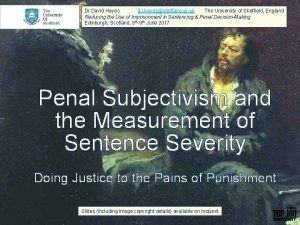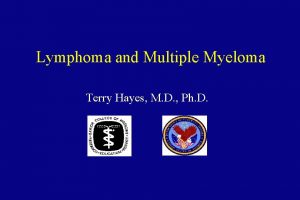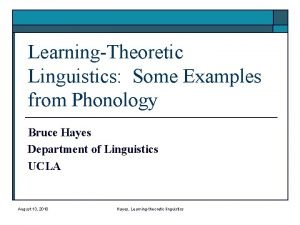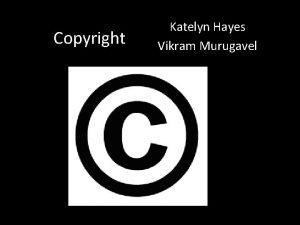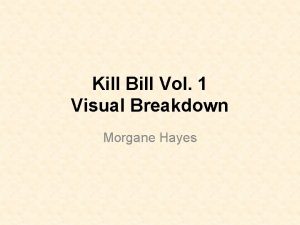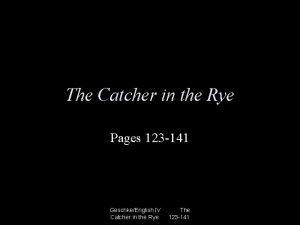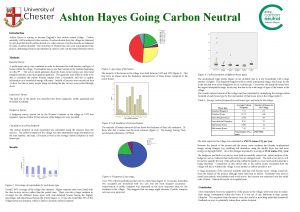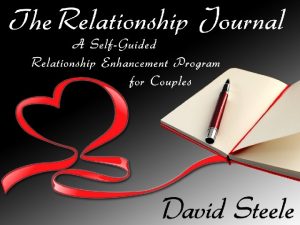Dr David Hayes d j hayessheffield ac uk











- Slides: 11

Dr David Hayes d. j. hayes@sheffield. ac. uk The University of Sheffield, England Reducing the Use of Imprisonment in Sentencing & Penal Decision-Making Edinburgh, Scotland, 8 th-9 th June 2017 Penal Subjectivism and the Measurement of Sentence Severity Doing Justice to the Pains of Punishment Slides (including image copyright details) available on request.

1. Measuring Penal Severity: Penal Objectivism and Subjectivism Penal Objectivism Penal Subjectivism Penal severity is determined by what the sentencing authority intends to bring about (Haque, 2013; cf. Mac. Pherson, 1967). Penal severity is determined by what the subject actually experiences (Sexton, 2015: 115). The harms of punishment should be divorced from the abstract, political deprivations that are deprived from offenders equally (Markel and Flanders, 2010; Gray, 2010; Markel et al. , 2011). The impact of punishment can vary sharply between individuals, undermining the ‘fit’ of their sentence (Kolber, 2009 a, 2009 b; Bronsteen et al. , 2009, 2010). Severity is measured in terms of quantitative, relative deprivation (e. g. liberty deprivation {Schiff, 1997}; living standards {cf. von Hirsch and Jareborg, 1991}). See generally Hayes (2016). Severity is measured empirically (Wood and Grasmick, 1999; Sexton, 2015; van Ginneken and Hayes, 2017; cf. Crewe, 2011).

2. “Liberty Deprivation” – The Objectivist Orthodoxy Historical and Modern Advantages of the Objectivist Orthodoxy Current Weaknesses of the Objectivist Orthodoxy Normatively attractive (Duff, 2001; cf. Elias, 1994). Descriptively unsatisfying (cf. Bronsteen et al. , 2010; Sexton, 2015). Epistemologically necessary (Mc. Pherson, 1968)! Epistemologically outdated (Sexton, 2015; Hayes 2016, 2017). Politically valuable: Ø State monopoly on the use of force (cf. Bloch, 1964); Ø Liberal equality before the law (e. g. Markel and Flanders, 2010). Ethically quietist about the ‘problem of punishment’ (Boonin, 2008; cf. Hudson 1987, 1993).

3. Subjectivism and Reducing Reliance on Imprisonment • There are two ways that (more) penal subjectivism would encourage lower reliance on imprisonment: a) The punitive capacity of CSMs and other non-custodial sentences can be more fully recognised; and b) There is more room for equivalence between sentences in practice. • N. B. Both of these points are focussed on England & Wales. It would be interesting to see how far your mileage varies.

3(a) Subjectivism and the Punitive Impact of Non-Custodial Penalties • ‘Liberty deprivation’ implies that ‘alternative punishments to imprisonment’ are inherently inferior (cf. Schiff, 1997). • But this denies the complex interaction of the pains of noncustodial sentences (e. g. Gayne and Painey, 1998; Durnescu, 2011; Hayes, 2015).

3(a) Subjectivism and the Punitive Impact of Non-Custodial Penalties • Moreover, specific policies could be reconceived so as to account for the penal impact (Hayes, 2016) of non-custodial options: • Offender Rehabilitation Act 2014: recognising the ‘pains of probation’ – replace, rather than supplement, short sentences; • s. 177(2 A) CJA’ 03: Any element can be ‘punitive’! Alertness to communication at trial and to context in punishment!

3(b) Subjectivism and Equivalence Custody s. 152(2) CJA’ 03 Community s. 148(1) CJA’ 03 Other Non. Custodial Sanctions Cf. generally Padfield, 2011. Not to

4. Challenges of a (More) Subjectivist Approach • Implicit bias effects (e. g. Lavinia Woodward; R v Olliver and Olliver (1989) 11 Cr App R (S) 10)? • Epistemological questions (e. g. Brock Turner; cf. Hayes, 2017); • Predictive Capacity Questions; • Procedural Questions (cf. Roberts (ed. ), 2011); • Normative Questions; • Ethical and Punitive Questions (see in particular Markel and Flanders, 2011: 915).

Conclusions • Penal subjectivism is no quick fix! E. g. imprisonment for breach. • Nor is it without its own challenges – pure subjectivism would be just as problematic as pure objectivism (Hayes, 2017). Much more research work is needed! • However, it is a potential tool of policy, sentencing decision-making, and academic/public discourse, with some potential to reduce reliance on imprisonment in E&W.

Bibliography • • • • • • • • • Andrew Ashworth (2015), Sentencing and Criminal Justice, Sixth Edition (Cambridge University Press). Marc Bloch (1964), Feudal Society, Volume Two: Social Classes and Political Organisation (Routledge). David Boonin (2008), The Problem of Punishment: A Critical Introduction (Oxford University Press). John Bronsteen, Christopher Buccafusco, and Jonathan S Masur (2009), ‘Happiness and Punishment’ 76(3) University of Chicago Law Review 1037 -1082. John Bronsteen, Christopher Buccafusco, and Jonathan S Masur (2010), ‘Retribution and the Experience of Punishment’ 98(5) California Law Review 1463 -1496. Nils Christie (1982), Limits to Pain: The Role of Punishment in Penal Policy (Martin Robinson). Stanley Cohen (1985), Visions of Social Control: Crime, Punishment and Classification (Polity Press). Ben Crewe (2011), ‘Depth, Weight, Tightness: Revisiting the Pains of Imprisonment’ 13(5) Punishment and Society 509 -529. RA Duff, Punishment, Communication, Community (Oxford University Press). RA Duff and Stuart P Green (2011), ‘Introduction: Searching for Foundations’, in: RA Duff and Stuart P Green (eds. ), Philosophical Foundations of Criminal Law (Oxford University Press), 1 -18. Ioan Durnescu (2011), ‘Pains of Probation: Effective Practice and Human Rights’ 55(4) International Journal of Offender Therapy and Comparative Criminology 530 -545. Norbert Elias (1994), The Civlizing Process: Sociogenetic and Psychogenetic Investigations (Edmund Jephcott, trans. , Revised edn. , Blackwell). David Gray (2010), ‘Punishment as Suffering’ 63(6) Vanderbilt Law Review 1619 -1693. Adil Ahmad Haque (2013), ‘Retributivism: The Right and the Good’ 32(1) Law and Philosophy 59 -82. David Hayes (2015), ‘The Impact of Supervision on the Pains of Community Penalties in England Wales: An Exploratory Study’ 7(2) European Journal of Probation 85 -102. David J Hayes (2016), ‘Penal Impact: Towards a More Intersubjective Measurement of Penal Severity’ 36(4) Oxford Journal of Legal Studies 724 -750. David Hayes (2017), ‘Proximity, Pain and State Punishment’ (forthcoming), Punishment & Society, available online in advance of publication, first published March 27 th, 2017, DOI: 10. 1177/1462474517701303. Barbara Hudson (1987), Justice through Punishment: A Critique of the ‘Justice’ Model of Corrections (Macmillan). Barbara A Hudson (1993), Penal Policy and Social Justice (Macmillan). Dan Kahan (1998), ‘Punishment Incommensurability’ [1998] 1 Buffalo Criminal Law Review 691 -708. Ian Loader (2011), ‘For Penal Moderation: Notes towards a Public Philosophy of Punishment’ 14(3) Theoretical Criminology 349 -367. Fergus Mc. Neill (2011), ‘Probation, Credibility and Justice’ 58(1) Probation Journal 9 -22. Thomas Mc. Pherson (1967), ‘Punishment: Definition and Justification’ 28(1) Analysis 21 -27. Dan Markel and Chad Flanders (2010), ‘Bentham on Stilts: The Bare Relevance of Subjectivity to Retributive Justice’ 98(3) California Law Review 907 -988. Dan Markel, Chad Flanders, and David Gray (2011), ‘Beyond Experience: Getting Retributive Punishment Right’ 99(2) California Law Review 605 -628. Matt Matravers (2016), ‘Punishment, Suffering, and Justice’, in: Stephen Farrall, Barry Goldson, Ian Loader, and Anita Dockley (eds. ), Justice and Penal Reform: Re-Shaping the Penal Landscape (Routledge), 27 -46. Nicola Padfield [2011], ‘Time to Bury the “Custody Threshold”? ’ 8 Criminal Law Review 593 -612. Jesper Ryberg (2010), ‘Punishment and the Measurement of Severity’, in: Jesper Ryberg and J Angelo Corlett (eds. ), Punishment and Ethics: New Perspectives (Palgrave Macmillan), 72 -91. Judah Schept (2015), Progressive Punishment: Job Loss, Jail Growth, and the Neoliberal Logic of Carceral Expansion (New York University Press). Mara Schiff (1997), ‘Gauging the Intensity of Criminal Sanctions: Developing the Criminal Punishment Severity Scale’ 22(2) Criminal Justice Review 175 -206. Lori Sexton (2015), ‘Penal Subjectivities: Developing a Theoretical Framework for Penal Consciousness’ 17(1) Punishment and Society 114 -136. Sonja Snacken (2016), ‘Punishment, Legitimacy and the Role of the State: Reimagining More Moderate Penal Policies’, in: Stephen Farrall, Barry Goldson, Ian Loader, and Anita Dockley (eds. ), Justice and Penal Reform: Re-Shaping the Penal Landscape (Routledge), 47 -68. Michael Tonry (2014), ‘Can Deserts be Just in an Unjust World? ’, in: AP Simester, Antje Du Bois-Pedain, and Ulfrid Neumann (eds. ), Liberal Criminal Theory: Essays for Andreas von Hirsch (Hart), 141 -165. Esther FJC van Ginneken and David Hayes (2017), ‘“Just” Punishment? Offenders’ Views on the Meaning and Severity of Punishment’ 17(1) Criminology and Criminal Justice 62 -78. Andreas von Hirsch (2017), Deserved Criminal Sentences (Hart). Andrew von Hirsch and Nils Jareborg (1991), ‘Gauging Criminal Harm: A Living-Standard Analysis’ 11(1) Oxford Journal of Legal Studies 1 -38.

Image Sources/Copyright • • Slide 1: Background Image: Ilya Repin, Refusing the Confession, c. 1879 -1885. Image source: https: //kuklybratc. ru/not-expect-him-ilya-repin. php Slide 6: Author’s own production. This diagram was first presented to the Annual Meeting of the European Society of Criminology Working Group on Community Sanctions and Measures on 1 st-2 nd June 2015 at the University of Sheffield. Slides available on request from <e. Mail: d. j. hayes@sheffield. ac. uk>. The diagram pertains to research described in Hayes, 2015. Slide 8: Author’s own production. However, both diagrams are derivative of Padfield, 2011, especially Figures 1 and 3. Slide 9: Image Collage, clockwise from top left: • • Detail of image of Lavinia Woodward, taken from Caroline Davis, ‘Student who Stabbed Boyfriend may Avoid Jail as it would “Damage Her Career”’, The Guardian, 16 th May, 2017. Available online from: <URL: https: //www. theguardian. com/uknews/2017/may/16/oxford-university-lavinia-woodward-stabbed-boyfriend-may-avoid-jail> (accessed 25 th May, 2017; Fair dealing); Image of Brock Turner, taken from Damon Young, ‘The Stanford Sexual Abuse Case: A White Privilege Cake with Vanilla Frosting on Top’, The Guardian, 6 th June, 2016. Available online from: <URL: https: //www. theguardian. com/society/2016/jun/09/standford-rape-case-white-privilege-brock-turner#img-1> (accessed 25 th May, 2017; Fair dealing); Ministry of Justice logo, taken from: <URL: https: //en. wikipedia. org/wiki/File: Ministry_of_Justice_logo. svg> (accessed 25 th May, 2017; Fair dealing); Detail from Anon. , Whipping of an Incarcerated Delinquent, 19 th October 1690. Taken from: <URL: https: //commons. wikimedia. org/wiki/File: Whipping_of_an_incarcerated_delinquent, _Germany_17 th_century. jpg> (accessed 25 th May, 2017; public domain); Sentencing Council logo, taken from: <URL: https: //www. sentencingcouncil. org. uk/> (accessed 25 th May, 2017, Fair dealing). Evelyn de Morgan, Cassandra, c. 1898. Taken from: <URL: https: //commons. wikimedia. org/wiki/File: Cassandra 1. jpeg> (accessed 25 th May, 2017; Public domain); Detail from William Hogarth, The Court, c. 1758. Taken from: <URL: https: //commons. wikimedia. org/wiki/File: William_Hogarth_004. jpg> (accessed 25 th May, 2017; Public domain). Slide design (including logos) and fonts, © The University of Sheffield, 2016 -17. Notes and content are my own work (you’d hope!)
